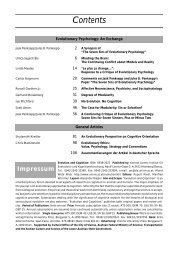Contents - Konrad Lorenz Institute
Contents - Konrad Lorenz Institute
Contents - Konrad Lorenz Institute
You also want an ePaper? Increase the reach of your titles
YUMPU automatically turns print PDFs into web optimized ePapers that Google loves.
An Evolutionary Model of the Effects of Human Paternal Resemblance on Paternal Investment<br />
tion should be overwhelmingly negative. When the<br />
two differ in relative proportions, an additive model<br />
would predict negation, which might result in indifference<br />
toward a child. Four different, discrete conditions<br />
could arise and were tested in a follow-up study:<br />
(1) a child shares no resemblance with dad and people<br />
do not ascribe resemblance of the child to dad, (2)<br />
a child shares no resemblance with dad, but people<br />
ascribe resemblance of the child to dad, (3) a child<br />
shares resemblance with dad, but people do not ascribe<br />
resemblance of the child to dad, and (4) a child<br />
shares resemblance with dad and people also ascribe<br />
resemblance of the child to dad. When predicting the<br />
behaviors towards the child and the viability of the<br />
child in terms of paternal investment, the last option<br />
would be the optimal condition and the first would<br />
be the worst condition if the assumption of additivity<br />
were adopted (see Figure 1 for a graphical depiction<br />
of the predictions). PLATEK (2002) tested an interaction<br />
between social mirror-mediated<br />
information and actual shared resemblance and<br />
found that males and females are affected similarly<br />
by social mirror information, but only males appear<br />
to be impacted by shared resemblance.<br />
An exponent term, 1/i, could be added to the<br />
equation to represent the number of offspring an<br />
individual has. As can be seen, increases in the<br />
number of offspring is predicted to yield decreases<br />
in the amount of investment, or increases in abuse<br />
by the male, because the probability that he has<br />
been cuckolded has increased, because each additional<br />
child that the mother bears represents an incidence<br />
in which an EPC could have resulted in EPP<br />
(BAKER/ BELLIS 1995; SCHACT/GERSHOWITZ 1963).<br />
With one child the probability of cuckoldry modeled<br />
here is GC k . With each additional child the<br />
male faces the possibility that he was cuckolded<br />
again; this would account for increases in the<br />
amount of abuse seen with each subsequent child<br />
in the birth order theorized here to be the result of<br />
increased psychological strain on mechanisms designed<br />
to assess resemblance and predict probability<br />
of cuckoldry. Abuse related to birth order effects<br />
has been demonstrated in humans (BURCH/GALLUP<br />
unpublished data; DALY/WILSON 1982; REGALSKI/<br />
GAULIN 1993). Further, additional children increase<br />
the strain on that male’s resources. Additional children<br />
represent increased costs; i.e., if he is now expected<br />
to invest more (e.g., time, resources, etc.) in<br />
offspring, this might occur at the cost of lost additional<br />
mating opportunities.<br />
PatI = P 1/i /C (4)<br />
An Alternative Model: Deception<br />
Detection and the Social Mirror<br />
The paternal resemblance component in the above<br />
equation assumes additive effects of actual and social<br />
mirror resemblance; i.e., the above model assumes<br />
that social mirror-mediated and actual paternal<br />
resemblance sum to produce an effect that is the<br />
probability of paternal investment. However, this<br />
may not be the case. Females may try to manipulate<br />
social mirror information to deceive males in to believing<br />
that an offspring shares genes in common<br />
with him and thus invest in offspring fathered by<br />
another male (DALY/WILSON 1982; GAULIN, personal<br />
communication; REGALSKI/GAULIN 1993). It would<br />
have behooved females to assert paternal resemblance<br />
if perceptions of resemblance translated to<br />
increased investment on the part of the male and<br />
that investment resulted in greater offspring survival.<br />
However, a male who blindly trusted a female’s<br />
assertions may have been at risk to invest in<br />
offspring to whom he was genetically unrelated. As<br />
a consequence of social mirror-mediated resemblance,<br />
perhaps being an instance of deception on<br />
the part of the female, it would have been in males’<br />
best interests to evolve a deception detecting mechanism;<br />
i.e., to question paternity when females enthusiastically<br />
assert paternity. This counter model<br />
can be modeled by subtly altering the original equation:<br />
thus,<br />
PatI = [(P rt )(IP rs Log 10 I) 1/i /C] = P' (5)<br />
PatI = P'/C (6)<br />
By representing social mirror-mediated resemblance<br />
as the absolute value of the base 10 log of the<br />
observed P rs , the return decreases the weight of the<br />
paternal resemblance term of the equation, thus<br />
lessening a male’s investment. When social mirrormediated<br />
assertions of resemblance ensue this effect<br />
is likely impacted by who is providing the information.<br />
For example, it might be the case that, when<br />
social mirror assertions are provided by the maternal<br />
relatives, males might place lesser weight on<br />
that information, and may even weight that information<br />
negatively. However, when social affirmations<br />
of resemblance are provided by the male’s kin,<br />
positive weights might be applied and the social<br />
mirror effect might have a greater impact on paternal<br />
investment (see below).<br />
Evolution and Cognition ❘ 195 ❘ 2003, Vol. 9, No. 2








